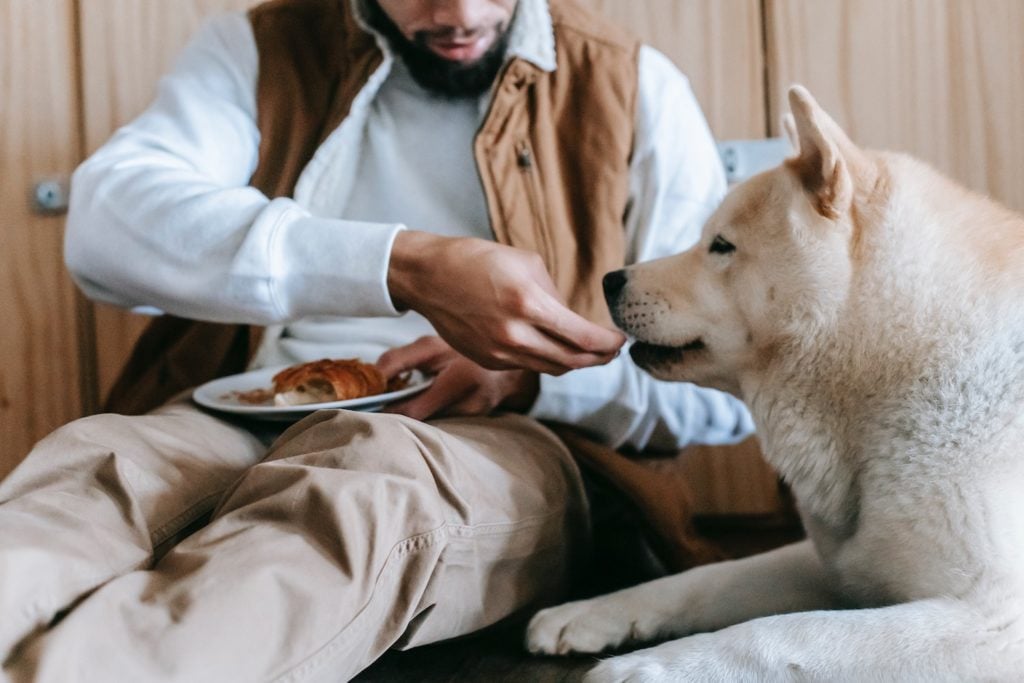Has your dog been turning up their nose at their usual diet? Are they running in the other direction when you get out their food bowl? Most dogs will undergo temporary inappetence throughout their life, usually lasting no more than a meal or two and resolving independently.
However, knowing how to stimulate your dog’s appetite can give you a leg up on helping encourage your dog to eat, especially if their lack of interest lasts for more than a day.
Why Would a Dog Lose Their Appetite?
Dogs can lose their usual enthusiasm for mealtime for many different reasons — there’s no one-size-fits-all answer. Understanding why your dog isn’t as interested in eating requires detective work and often a trip to your veterinarian, as several serious health conditions can trigger this response.
For example, conditions like cancer, kidney disease, inflammatory bowel disease (IBD), and other GI diseases (like pancreatitis) can make your dog far less interested in eating.
Acute conditions can temporarily suppress your dog’s appetite, like dental issues or pain from an injury. It’s always a good idea to check your dog’s teeth regularly, as many dogs won’t show signs of an issue until it’s advanced. Other emergency situations, like a blockage or bloat, can also impact their interest in eating and will need to be treated immediately.
In addition to physical health concerns, mental stress can also influence your dog’s appetite. Think about the last time you went through a period of stress — how interested were you in eating?
Dogs may be unable to express their stress level out loud, but they can feel it just the same. If you’ve ruled out physical causes, look at your dog’s environment. If you can’t find any triggers, consider hiring a dog behaviorist.
Another thing to consider if your dog isn’t eating as well as they used to is the position of their food bowl. Bending over to eat may not be a problem for younger dogs, but it can cause pain in dogs as they age. Some dogs may negatively react to eating because they associate it with pain.
What Can Happen If a Dog Doesn’t Eat?
A dog who skips a meal or two isn’t in much danger, but missing more than that can cause some serious health complications. Dogs need calories to keep their body functioning optimally, so missing out on those calories means their body has to choose what to keep going at full capacity.
The other problem you’ll run into if your dog won’t eat is that they are at a higher risk of dehydration, especially if they’re not drinking water. Dehydration is a much more serious problem, as it can lead to organ failure and even death if allowed to go on too long without treatment.
How To Stimulate Appetite In Dogs
If your precious pet is turning their nose up at the food bowl, there are a few tips and tricks to get them interested in eating again. None of these suggestions should be used in place of a complete check-up from your veterinarian, though, especially if your dog isn’t the type to say no to a meal.
Incorporate Canned Food Into Their Diet
The first thing you can try to stimulate appetite in dogs is to mix up what they’re actually eating at mealtime. Although dogs don’t think of their diet in the same way we do — they don’t need to be the first in line when the next new restaurant opens — it is possible for them to get bored with their ordinary diet.
Adding just a few scoops of wet food can keep their regular diet interesting, especially if you heat it up first. However, don’t just head to the store and grab any can of dog food off the shelf. Try to stick with canned food that is as close to their dry food diet as possible (if you can actually get the same brand, that’s even better).
In a worst-case scenario where you really need to get your dog to eat, you can mix in a little bit of human baby food. Just make sure you’re choosing an option that doesn’t contain any garlic or onion — just plain turkey or chicken works great (as long as your dog doesn’t have an allergy to either of those proteins).
There is always a risk of GI issues when incorporating new foods into your dog’s diet, so make sure you’re keeping an eye out for any nausea, vomiting, or changes in their bowel movements.
Use Healthy Treats in Moderation
Sometimes all it takes to get your dog interested in eating is to entice them with some healthy treats. Notice we said healthy — as tempting as it is to sneak your dog a piece of your fast food cheeseburger, you’ll want to stick with snacks that are good for them.
Feeding your dog something fried or greasy can increase their risk of getting an upset stomach or even a dangerous issue called pancreatitis.
Stick with fresh fruits and vegetables and foods on the ASPCA dog-safe list, like apples, bananas, carrots, green beans, and peanut butter — all in moderation. When in doubt, check with your veterinarian to see if it would be safe for your dog to eat (especially if they are taking medications to treat any chronic health conditions).
Remember, even the healthiest snacks shouldn’t make up more than 10 percent of your dog’s daily caloric intake. Obesity is just as much a concern in dogs, leading to various negative side effects for their overall health and wellness, so use snacks only in moderation.
Change Up Their Mealtime Routine
Most of us love praise — doesn’t it motivate you to do something when you’re being told how great you are at it? Dogs also thrive when they’re being praised, which is why many of them learn best with positive reinforcement (just saying “good boy” works as well as nearly any treat).
If your dog seems to be snubbing their food, try changing how and where you’re feeding it to them. Sit with them and offer a few bites out of your hand, or sit on the floor with them while they eat. Be careful if your dog has food aggression, as too much contact with the food bowl can be dangerous even with the most loving dog.
You’ll also want to take a step back and look at their dining environment from a broader perspective. Do you have other pets? Is their food bowl located close to a busy area of the home?
They could be uncomfortable eating because they’re either distracted or feel unsafe. Changing where they’re eating or allowing them time to eat by themselves can be what they need to get back to eating normally.
Make Sure They’re Getting Plenty of Exercise
Boredom in dogs can lead to depression, although dogs don’t show it as we do. A dog who does the same thing, day in and day out, may start to lose interest in playing or eating and choose to stay in bed instead.
To help counteract boredom, ensure you’re getting them their recommended daily exercise. Most dogs need at least half an hour a day (preferably more, especially if they’re an active breed) to keep them happy and healthy. This exercise doesn’t always have to be a walk or run; many dogs do just as well with a vigorous round of fetch or tug-of-war.
You can also provide them with toys that keep them interested — stuffed Kongs, interactive puzzle toys, etc. Change these toys up regularly so they don’t get bored. Some of these toys can also be used to feed their meals, making them a game.
Consult Your Veterinarian
Even if your dog has already been checked out by your veterinarian and given a clean bill of health, it may be worth talking to them about prescription medications if they’re still not wanting to eat.
Certain prescription medications, like Mirtazapine, Meclizine, and Cerenia, can help reduce feelings of nausea. Newer drugs like Entyce are also available, which help mimic the hormone that makes a dog feel hungry. Work with your vet to find the right combination of medications and dietary recommendations to get them interested in eating again.
Never give any over-the-counter human medications without your veterinarian’s recommendation.
In Summary
Knowing how to stimulate an appetite in dogs can help if your pet starts to turn their nose up at their usual diet. While a lack of appetite can point to a health condition that will need to be addressed by your veterinarian, trying things like mixing in a bit of canned food or sitting with them while they eat can help them get over the hump.
Our dogs need their nutrition to stay healthy, and it’s up to us as pet parents to get them what they need.
Sources:
Pancreatitis in Dogs and Cats – Digestive System | Merck Veterinary Manual
Sharing is Caring: Foods You Can Safely Share with Your Pet | ASPCA









